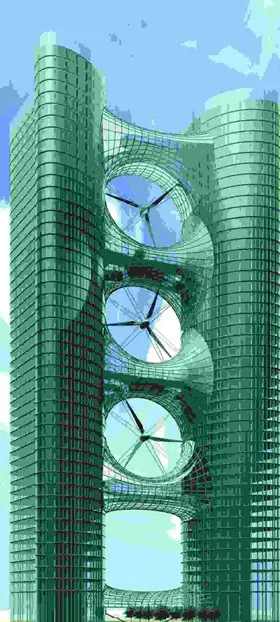Wind and Architecture
Abdel Rahman Elbakheit 1 College of Architecture and Planning, Department of Architecture and Building Sciences, King Saud University, Riyadh, Saudi Arabia
Abstract
In this chapter, the influences of wind on architecture are highlighted. Wind can have both positive and negative effects on architecture. Moreover, architecture can respond in proactive ways to maximise the benefits of wind forces and reduce or eliminate the negative impacts. This chapter sheds further light on notable architectural ideas translated into architectural case studies on harvesting wind energy in the built environment. Moreover, this chapter enables gaining insight into successful practices in architectural design solutions and ways and means to further enhance the performance of the buildings. In addition, the negative impacts of high wind velocities are identified, and possible solutions to mitigate them at their source are presented and discussed. Optimised architectural forms that can completely avoid excessive wind forces and devastating vortex shedding during the design stage are presented.
Keywords: Architectural forms, Aerodynamic architectural optimisation, Architectural form finding, Architectural stability, Vortex shedding, Wind energy, Wind energy harvesting, Wind forces.
* Corresponding author Abdel Rahman Elbakheit: College of Architecture and Planning, Department of Architecture and Building Sciences, King Saud University, Riyadh, Saudi Arabia. E-mail:[email protected] 1. INTRODUCTION
Mankind encountered wind and its effects from the dawn of existence. The history of using this renewable energy source has been well integrated in human civilisation, being implemented for sailing boats and operating wind mills [1], wind catchers [2], etc. However, for buildings in general, architectural form in particular, wind is associated either with structural safety or ventilation of interior spaces. With technology advancement, structural safety and ventilation have developed to be well established aspects of architectural form, although under different specialisations: structural safety under structural engineering [3] and ventilation under mechanical engineering [4]. However, architectural design retained the initiative of combining these two, among others, to produce more environmentally friendly buildings. Thus, the need to adequately benefit from wind arose. In other words, the need to find a way to tame the giant to harvest its energy at the point where it is made. In this regard, some notable conceptual architectural ideas put forth by architect Bill Dunster [5] were ground breaking, wherein he proposed the integration of a flower-shaped structure with at Tall
building concentracting and accelerating wind flow for energy harvesting.Another wind energy harvesting design was developed by the European funded project of ‘WEB – JOR3-CT98-0270’ [September 1998–August 2000] [6], which performed a systematic study on the generation of wind flows by design manipulation to enhance wind energy harvesting. This study included the use of two large kidney-shaped towers that channel and accelerate wind flows between them, where large turbines are present. A prototype was erected and tested. Fig. (1) shows this prototype, which was designed under the collaborative efforts of Imperial College London, Mecal applied mechanics (i.e., consulting firm), University of Stuttgart, and BDSP partnership Ltd. (i.e., engineering consulting firm). This project highlighted that this architectural design enabled increasing wind energy generation by a factor of at least 25% compared with the annual yield of the same turbines under a standalone scenario.
Fig. (1)) Conceptual architectural design of kidney-shaped twin towers with three horizontal-axis wind turbines integrated, having diameters of 35 m and generating 250 kW of power [
8].
Derek Tayler of Altechnica [7] invented ‘the Aeolian roof’ that contained a pitched roof with a flat wing at the ridge, which accelerated wind in this area. Wind turbines were then proposed to be used to harvest energy from this accelerated wind.
In 2005, a report was published from the joint venture of the Carbon Trust UK and some consulting and research bodies such as Imperial College London and Altechnica. It detailed the potential of building-integrated wind turbines.
2. Examples of Fully Developed Architectural Designs for Wind Energy Harvesting
Recently, some projects involving architectural forms incorporating wind turbines have been completed around the globe, such as the Bahrain World Trade Center (BWTC) in Manama, Bahrain, Strata SE1 in London, UK, and Pearl River Tower in Guangzhou, China.
Fig. (2)) Schematic of the Bahrain World Trade Center, Gulf view.
2.1. Bahrain World Trade Center
The BWTC is a man...


